Contemporary Urban Trains of Tōkyō
Development of JR East’s E231 series
There are numerous different kinds of trains in use in Tōkyō today, many tailor-made to specific operating requirements, and operated by several companies. But JR East operates the most trains. Today, JR East has over 8,000 train cars operating in the Tōkyō metropolitan area, and has been working to standardize them, to the extent possible, for decades.
Note: this page does not include all models of trains used by JR East in the Tōkyō metropolitan area. In particular, it is focused on the models used as urban (as opposed to suburban) commuter trains, excluding most suburban and limited express models. Some models of urban commuter trains that exist or existed in small quantities are also omitted, and the emphasis is on trains still operating in Tōkyō today.
Urban trains are distinct from subway trains, although they share many common features, and some urban lines operate run-through services onto subway lines. Trains in general are narrow gauge, heavy rail vehicles, similar to those used by most Tōkyō subways, but are typically longer and wider than trains designed for subway tunnels. They operate above-ground, often on raised structures or fills, but sometimes at street level or in open cuts. In some cases they do operate below-ground.
The 103 Series
When it was formed in 1987 the Japan Rail Group (JR Group) inherited a large fleet, numbering several thousand, of the 103 series cars that Japan National Rail (JNR) had been using since 1963, along with a substantial number of other models. These were solid, reliable, vehicles. But they were expensive to operate and maintain, and JNR had been losing money badly, so a new design that improved on them was a high priority for the newly formed JR Group and its subsidiaries. One of them, JR East, began work on a new model intended to cut weight and cost (and service life) by 50%, although this was based in part on work already begun by JNR.
The 103 series trains were made of steel, which had to be painted periodically to avoid rust, and were heavy. Additionally they consumed more electricity than necessary to operate; two decades of experience with the Shinkansen had led to many developments in control and propulsion systems that could improve operating efficiency. But, although the 103 collected power via pantograph from overhead catenary wiring like most Japanese electric trains, it and other urban trains used 1,500-volt DC, so they could not directly adopt the 25,000-volt AC-power systems used on the Shinkansen.
JNR had previous experience with new train designs (the 203 series of aluminum-bodied cars, built in limited numbers from 1982-1986, for example), but had never committed to large-scale replacement of the 103 series. In fact, they continued constructing new examples up through 1984, a production period of over twenty years. The last JR East 103 train was scheduled to be retired in October of 2009, although the model remains in use by other JR regions, so the design will eventually have served for more than half a century, making it a very successful design indeed.
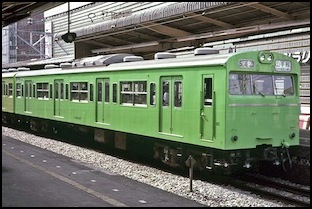
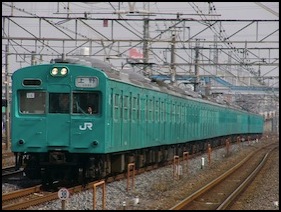
103 in Yamanote Line color (1985), and in Jōban Line color (2003)
Photographer: 永尾信幸, Chabata_k (Japan)
The 205 Series
The 205 series was introduced in 1985 by JNR, and inherited by the JR Group companies, including JR East. This was the first significant replacement for the 103 series. It introduced lower weight cars (an average 29.9 gross tons per car, versus 35.9 gross tons for the 103 series cars), regenerative braking to return energy to the power grid when trains stopped at stations, and the first use of stainless steel bodies, but continued to use six motorized cars per ten-car set (as did the 103) and standard DC motors. It also continued to use resistor-based power controls, which were inefficient. Stainless steel was important because, despite the higher initial cost, it avoided the need for painting to prevent rust, lowering maintenance costs, as well as reducing weight.
Trains of the 205 series continue in use today on many lines of JR East and other railways, although predominantly in outer suburban commuter service (they were removed from the Yamanote line in 2005, and from other downtown lines prior to that).
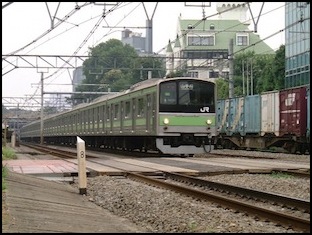
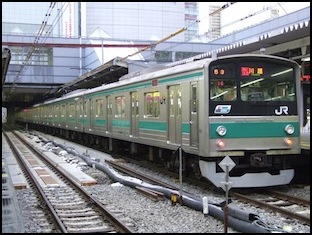
205 in Yamanote Line color (2000), and in Saikyō Line color (2007)
Photographer: pyzhou, Lover of Romance
The 209 series
The 209 series was the first product of JR East’s quest for lower-cost vehicles, and began replacing the 103 series starting in 1993. It further reduced weight (to an average of 24.1 gross tons per car), and included AC-based induction motors (the DC supply voltage is converted to AC onboard to drive the motor) with Variable-Voltage, Variable-Frequency (VVVF) inverters and GTO (Gate Turn Off) semiconductor switching controls, which provided a number of improvements in control over earlier pure DC systems. The number of motorized cars per train was reduced from six to four. Extensive interior use of plastic was also made, to further reduce weight, and the design raised the top speed from 100 kph to 110 kph. The 209 series is reported to have reduced maintenance by approximately 50% from the 103 series (although some of those gains were likely realized with the 205 series).
Several different variations on this design have been built, identified by series numbers (e.g., the 209-1000 series used on the Jōban Line) and models continue in use today.
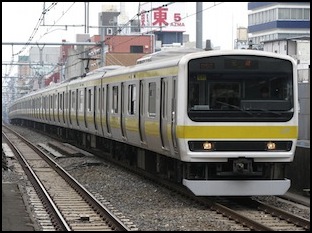
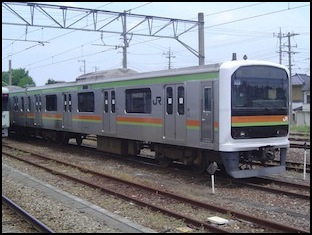
209 in Chūō-Sōbu Line color (2009), and in Kawagoe Line color (2006),
Photographer: TC411-507, Kone
The E231 Series
The E231 Series followed the 209 in 2000 (a prototype was in use from 1998), and is essentially a refinement of it. There was an intermediate E217 Series (see also my Suburban Trains page) built for outer suburban use which looked different, but had many of the same technical advances of the E231. Both provide a top speed of 120 kph, slightly higher than that of the 209 series. On the Yamanote line top speed is limited to 90 kph.
Externally, the 209 and E231 are very similar, with the E231 using a slightly wider 2.95m body than the 2.8m body of the 209 and other prior trains. There are significant variations between the models of each used on various lines, some of which are visible (e.g., the separate headlight surrounds of the Yamanote train below), further complicating identification.
The E231 brought improvements in power efficiency, lower weight (partly through reduced wiring) and increased crash-protection for grade-crossing accidents (important in outer suburban use). The prototype was originally classed as the 209-950 series, before being renumbered as the E231-900 series when it was brought up to the final E231 specification. The E231 is reported to weigh 66% of what the 103 series train did (thus, roughly 23.9 gross tons per car), although I haven’t been able to find specific numbers for it.
One of the big advances of the E231 is the Train Information Management System (TIMS), an onboard data network replacing separate control wires for different purposes, operating at a speed of 2.5 Mbps. TIMS enables detailed displays of information for passengers, as well as providing control and monitoring capabilities for the vehicle. TIMS also plays a role in improving maintenance efficiency (probably by collecting and reporting “hours of use” and other statistics for individual subsystems). TIMS, particularly in conjunction with D-ATC (see below), also allows more precise control of braking, which leads to a smoother ride for passengers.
JR East typically operates the E231 in 10-car sets using four powered cars, each with four 95 kilowatt electric motors per car (one per axle). Not every powered car has a pantograph. Typically the four cars are arranged as two paired units in different parts of the train, and one car in each pair has a pantograph. On the Yamanote line, the 11-car trains include six powered cars, otherwise identical (the E217 also used six powered cars per 10-car set). Motor controls use VVVF inverters with IGBT (Insulated-Gate Bipolar Transistors) switching.
For comparison, an E231 train with four power cars develops a total of 2,038 horsepower, while the models with six develop 3,057 hp. A typical American locomotive-hauled commuter train of the same period uses a similarly-sized engine (an F40PH locomotive with 3,000 hp or an F59PH locomotive with 3,200), but with significantly heavier cars due to Federal regulations on crashworthiness. A typical U.S. commuter car weighs about 65 U.S. tons (130,000 pounds), while a locomotive is more than twice that. The 209 series cars have an average gross weight per car of 24.1 metric tons, or about 53,000 pounds (the E231 is variously said to be the same weight as, or somewhat less than, the 209). Thus the power to weight ratio of an eleven-car Yamanote E231 train is roughly that of a three-car US commuter train (including the weight of the locomotive), and about twice that of an 8-car U.S. train.
Another innovation of the E231, found on the Yamanote Line’s E231-500, was the use of a digital version of Automatic Train Control (D-ATC), first used on a segment of the Keihin-Tōhoku line on converted 209 series trains in 2003. The Yamanote line converted to D-ATC in 2005 after the E231 replaced earlier trains on it. D-ATC allows control of the throttle and brakes to be controlled from the train, and tuned to the characteristics of the train. This results in closer possible spacing of trains as well as smoother operation for passenger comfort.
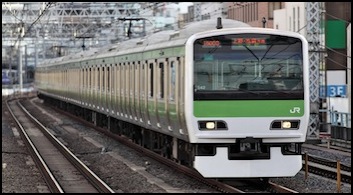
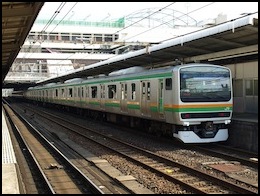
E231 in Yamanote Line color (2009), and in Shōnan-Shinjuku Line color (2008)
Photographer: 天然ガス (Tennen-Gas), 七号
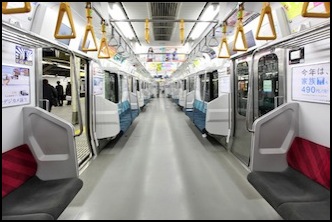
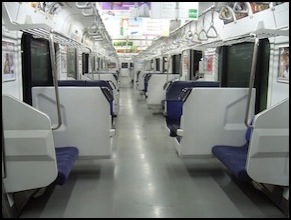
Interior of a Yamanote Line E231 (2009), and Interior of a Suburban E231 (2006)
Photographer: 天然ガス (Tennen-Gas), Bakkai
E231 Derivatives
The E231 itself was designed to be a platform that could be customized for a variety of different conditions. Variations include side-by-side seating for outer suburban commuter use versus along-the-wall seating for urban commuter trains (as seen above, and described in more detail on the JR East Suburban Trains page). But some variations have been substantial enough to be given a unique designation, rather than just being a series number of E231. These include the E233 and E531. Production of new E231 units appears to have ceased in 2011, now replaced by the E233 series for new construction, although most of those built (2,600 of 2,700 cars) remain in service.
The E233 Series trains were introduced on the Chūō (E233-0), Keihin-Tōhoku (E233-1000) and Jōban (E233-2000) lines starting in 2006, and the Tōkaidō Main Line (E233-3000) starting in 2008. There are three slightly different designs, with their own series numbers. These are the same size and general appearance as the E231 (the Jōban trains are slightly different due to clearance issues), but provide faster acceleration, redundant systems to avoid stopped trains due to equipment failure, and improvements in accessibility for passengers in wheelchairs or with other mobility problems. They also use colored LCDs for destination information, to allow for color-coded displays. To some extent these make use of technologies explored by the “AC Train” prototypes (see below), but not all of them. The Jōban model has a front emergency exit on the cab car due to use in tunnels.
The E233-2000 variant is narrower (~2,800mm vs 2,950mm), with lower floors (1,130mm vs 1,200mm), and equipped with an emergency exit on the ends. It is intended for through running between the JR East Jōban line and the Tōkyō Metro Chiyoda subway line. A prototype was introduced in 2009, and production of the remaining sets was planned for 2010, to replace the 17 existing 203 Series train sets used for that purpose since 1982. The E233-2000 design was also used in 2013 for trains for the Toei Shinjuku and Keio lines designated 10-490F series, replacements for the older 10-300.
There is also an E233-3000 version used as a suburban train on the Tōkaidō Main Line, see the JR East Suburban Trains page for information.
Finally, there is an E233-5000 version in use on the Keiyō Line from 2010, replacing 201, 205, and 209-500 trains.
The E531 Series is an AC/DC dual-mode train, for use on outer parts of the Jōban Line, where AC power is used in part. It has a maximum speed of 130 kph. See the JR Suburban Trains page for more information.
Additionally, the design features of the E231 have been adopted by other railways, either directly or in part. Examples of this include the Sagami Railway’s Sōtetsu 10000 Series and the Tōkyū Corporation’s 5000 Series trains, which use slightly different bodies, and more powerful propulsion motors (and more of them: five powered cars in a 10-car set) to provide faster acceleration on lines with frequent stations, but are otherwise based on the E231.
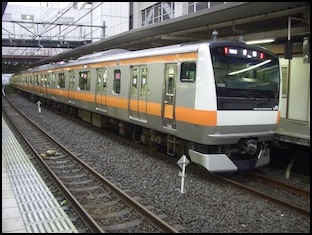
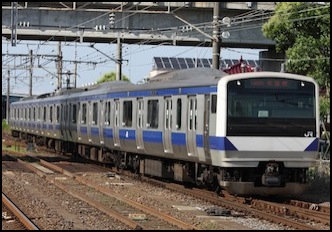
E233-0 in Chūō Line color (2009), Photographer, and E531 in Jōban Line color at Tsuchiura (2008)
Photographers: Mykazetachi, and TC411-507
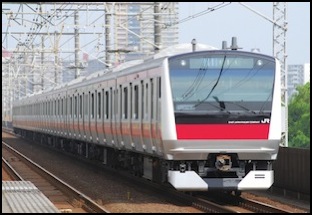
E233-5000 on Keiyō Line (2010)
Photographer: toshinori baba
AC Train and the E331
Following the E231, JR East is now working on an “AC Train” (Advanced Commuter Train) initiative to develop their next-generation of commuter vehicles. These will incorporate numerous safety and operational improvements, and access improvements (e.g., a built-in “wheelchair step” to bridge the gap to platforms and a sloped floor at the door to correct for the difference between modern train floors and older platforms). The new vehicles will also be even more recyclable than the current E231 due to expanded use of recyclable materials in their assembly.
The AC train uses articulated cars, where a wheel assembly is shared between two cars (a technique used on the French TGV, among others) to lower weight and rolling resistance. Another new development planned for the AC Train is the “direct drive” motor. Rather than being connected to the axle by gears, the axle itself forms part of the motor. This yields higher efficiency and lower noise.
A prototype, known as the E331 Series, is reported to be in revenue service on the Keiyō line. It is based on an earlier development prototype known as the E993.
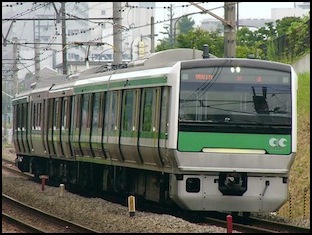
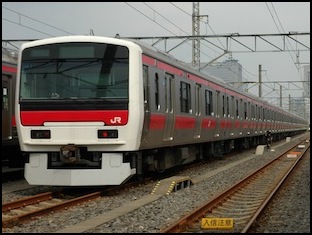
E993 in 2004, and E331 in 2006 at Keiyō Depot
Photographer: Chabata_k(Japan), Ma4
- end -
References
Some of the information provided here came from the Wikipedia articles linked above, while other details were compiled from print and web sources. Among these were:
Initiative to Standardize Tokyo Commuter EMU’s, by Satoru Sone,
Japan Railway and Transport Review, #41, pg. 24
Twenty Years of JR East - Making a Fresh Start to Shape the Future, by East Japan Railway Company
Japan Railway and Transport Review, #49, pg. 18
Developments in Electric Power and CO2 reduction on the Japanese Railway, by Dr. Keiji Kishi
Life Cycle Engineering of Rolling Stock, by Takashi Endo, JR East
History of JR East Commuter Trains, by Hiroshi Nomoto
JR East Technical Review #05, Winter 2005
Toward Creation of a Railway Car Meeting the 21st-century Requirements - Development of AC Train, by Mitsuyuki Osawa,
JR East Technical Review #01, Autumn 2002
Towards Realization of a Next Generation Commuter Train System, by Minoru Ogasawara
JR East Technical Review #05, Winter 2005
Commuter Bi-Level for Massachusetts Bay Transportation Authority (MBTA), page on Kawasaki Heavy Industries website
An Overview of Chuo Line Rapid Service Series E233 Railcars, by JR East (one page diagram and list of highlights), and a related Press Release regarding the E233 series cars.
railf.jp post on the Toei 10-490F




